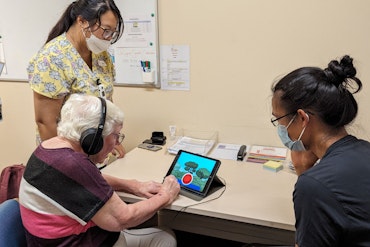How can aged care change to help us live at home longer?
![<p>Bede Hackney, head of Zoom, Australia and New Zealand, shared his thoughts on autonomy, automation and innovation. [Source: Shutterstock]</p>](https://agedcareguide-assets.imgix.net/news/articles/wp/agedzzcarezoom.jpg?fm=pjpg&format=auto&w=550&q=65)
Bede Hackney, head of Zoom, Australia and New Zealand, shared his thoughts on autonomy, automation and innovation. [Source: Shutterstock]
Key points:
- Minister for Health and Aged Care Mark Butler said older Australians are keen to live independently and at home for longer
- Melbourne-based nursing care provider, Caring For You had successfully adopted digital technologies to scale their business and improve communication, resulting in increased efficiency and enhanced customer care
- Automation could transform aged care by facilitating non-intrusive tasks and enhancing the patient journey, according to Head of Zoom, ANZ, Bede Hackney
Recent industry initiatives in the 2023 – 2024 Federal Budget have prompted Zoom’s ANZ Head Bede Hackney to reflect on challenges faced by the healthcare industry in the near future.
Victorian Nursing care provider, Caring For You shared that adopting digital technologies was especially crucial in helping scale their business and improve communication with customers and members. They can now make 33,000 calls a week compared to only 2,000 prior to technology adoption. Naturally, Mr Hackney saw the boom of Zoom throughout the pandemic and its adoption as a new avenue for efficacy in the industry.
“There are efforts being made to better support providers to adopt flexible models. This year’s State Budget announced an $824.4 million investment in digital health, to support initiatives like MyMedicare which aims to bridge the gap between healthcare practitioners and their patients,” Mr Hackney told Talking Aged Care journalist David McManus.
When asked about the potential impacts of providers relying on technology as a shortcut which may have adverse effects on care recipients, the Zoom head had a few choice words for sceptics of technology adoption.
“Rather than a shortcut, automating aged care is a necessary step forward.”

“Providers can consider a flexible work model that combines virtual and on-site care. This could include digitalising essential administrative functions like patient data collection and filing, billing, vendor meetings, and employee relations to improve efficiency, reduce costs and increase access,” Bede said.
He attested to the fact that caring for this growing demographic will require an increase in the number of healthcare workers across various sectors, including hospitals, clinics, nursing homes, and community active ageing centres.
The Government has allocated $11.3 billion to increase pay for the aged care workforce, following the Federal Budget announcement for 2023 – ‘24. Although Mr Hackney considered the portion of the Government Budget directed towards recruiting, training and retaining healthcare staff to be significant, he believed the demand for healthcare services continues to outstrip supply, putting pressure on healthcare workers.
“The aim of employing technology in this sector is to make the experience, of both the carer and patient, as seamless and simple as possible,” he continued.
“It gives patients the option to choose — if a patient is more comfortable with receiving an in-person check-up, they have that option. However, you’ll find that older Australians increasingly want to receive aged care and live independently in their own homes.”
According to the Australia Medical Association [AMA], the estimated benefit of telehealth from reducing travel in 2021 – ‘22 was $1.35 billion. AMA analysis demonstrates that further integration of telemedicine across both the public and private sectors, including telehealth appointments, remote monitoring, out-of-hospital care, and use for prevention and early intervention could save up to around $14 billion each year.
“This can be explained due to their value of comfort and commitment to staying in the same place for longer, and the possibility of this is hugely reliant on digitising healthcare,” Mr Hackney said.
“Automated features can make the patient journey smoother and more efficient. This could be automated transcription and translation on teleconsultation platforms, or a virtual receptionist greeting patients and directing them to the right appointment rooms. We also offer resources online to give health professionals the tools they need to guide patients or team members in this shift.”
The Zoom head said healthcare initiatives announced in the Budget have led him to believe “[…] technology in healthcare can no longer be seen as a temporary solution to address emerging needs. Instead, it is a critical enabler of a more sustainable and resilient healthcare system that can meet future needs.”
“Adopting automation has huge potential to benefit providers, especially those in regional Australia who might be more stretched for time and resources, enabling them to deliver better care to patients in the community. For example, tasks like the delivery of medicine and follow-up consultations can be automated,” Mr Hackney added.
“While this directly benefits the provider, this can also support those receiving care by increasing access to resources. With less pressure on staff, the quality of care can also be improved.”
Bede concluded that the cost savings providers can make from adopting solutions like a modern cloud phone system with automation features would enable them to reallocate those resources to provide better care.























